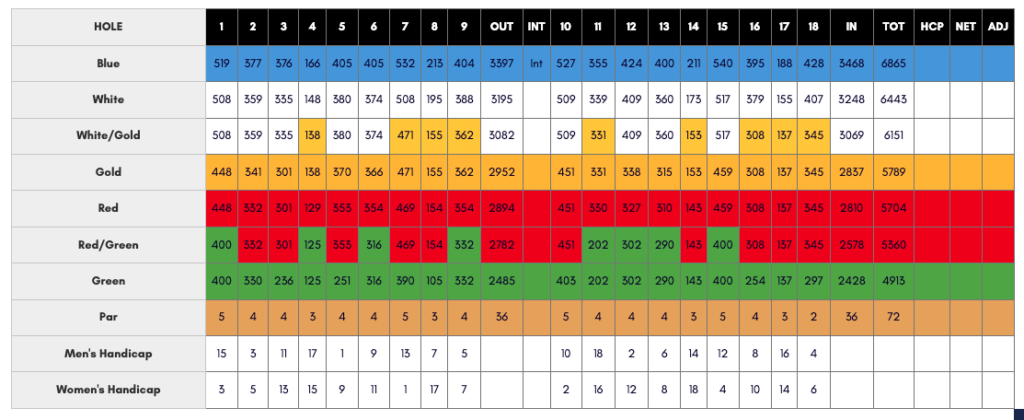Marine Memorial Golf Course
MARINE MEMORIAL GOLF COURSE AT CAMP PENDLETON
Golf tournament:
Golf Tournament August 25, 2023
Camp Pendleton North, California, United States


Golf never gets old! From beginners to seasoned golf enthusiasts, your MCCS golf course has everything you need to start your game today. Our PGA professionals are happy to help you get fitted for your very own set of golf clubs, teach basics and course etiquette, or even just give you a pointer or two to help you with your swing! MCCS offers daily play, golf leagues, tournaments, outings, instructional programs, exhibitions, events, and summer youth activities. Grip it and rip it with MCCS!
Unyielding to the seasoned, yet playable for the novice, William P. Bell’s Marine Memorial Golf Course has been praised for its bunkers, ingenuity, and innovations in golf course construction. Enjoy the Marine Corps heritage of this course and play for the history, the heroes, and the tradition.
Open to the public. Apply for base access. There is a one-week wait for processing. Once approved, access is valid for 90 days.
| 6,865 yards from the Tip | Chipping Areas |
| 18 Hole – Par 72 | Non-Metal Spike Course |
| Sand Bunkers | Natural Grass Driving Range |
| Practice Putting Green |

Marine Memorial Golf Course (MMGC) onboard Camp Pendleton is the ultimate jewel of Windmill Canyon. With rolling foothills and mature trees, this is one of Camp Pendleton’s best treasures. It boasts an 18-hole championship course that challenges the seasoned golfer yet is playable for the novice. Playing 6,865 from the tips, this par 72 layout takes full advantage of its beautiful and secluded natural setting. MMGC is not just a golf course, it honors the United States Marine Corps (USMC) with each of its tee box markers highlighting USMC history and battles, from the birthplace of the Corps to the Battle of Ramadi. We Are Golf To The Corps!
Watch Us Grow! Marine Memorial Golf Course has restored the “Golden Era of Golf”! Bunkers on the course are now set to the original William P. “Billy” Bell Sr. design*. Construction on the restoration is complete. We currently have the whole course open for play. Please see pics attached
*The Bells are considered California’s First Family of Golf Design. From the 1930s forward, William Park Bell (also known as Billy Bell) was one of the West’s most prolific course architects. Among his most significant designs were the La Jolla Country Club, both courses at Brookside Golf Club in Pasadena, and the San Diego Country Club.
During World War II, Bell Sr. served as a turf consultant to the U.S. Army Corps of Engineers and was awarded a commendation by the Southern California chapter of the PGA, in honor of his work creating golf courses for wounded service members. After the war, he was joined by his son William Francis (also known as Billy Bell Jr.) in the family design business.
Billy Bell died in 1953, leaving behind his vision for the design of Torrey Pines Golf Course in San Diego. Billy Bell Jr. went on to make the vision a reality and oversaw the course’s creation in the late 1950’s.
Designed by visionary golf course architect William P. “Billy” Bell, Marine Memorial Golf Course has been praised for its bunker shaping, ingenuity, and innovations in golf course construction. It is Bell’s finest 18-hole PGA championship course.
Descriptions of Holes – USMC Battles
Hole 1 – Tun Tavern: A committee of the Continental Congress met at Tun Tavern to draft a resolution calling for two batallions of Marines able to fight for independence at sea and on shore. The resolution was approved on Novemver 10, 1775, officially forming the Continental Marines.
Hole 2 – Tripoli: The First Barbary War (1801-1805), was the first of two Barbary Wars, in which the United States and Sweden fought against the four Barbary States. The cause of the U.S. participation was due to pirates from the Barbary States seizing American merchant ships and holding the crews for ransom. The First Barbary War showed that America could execute a war far from home and that American forces had the cohesion to fight together as Americans, rather than separate statesmen.
Hole 3 – Battle of Derna: The turning point in the First Barbary War was the Battle of Derna (April-May 1805). This was the first time the United States flag was raised in victory on foreign soil. The action was memorialized in a line of the Marines’ Hymn – “the shores of Tripoli.” It is fabled that Lieutenant O’Bannon performed so heroically that he was presented a sword from Pasha Hamet Karamanli. The sword later became the pattern for the swords that are carried by the Marine Corps officers today.
Hole 4 – Battle of Chapultepec: The Battle of Chapultepec in September 1847 was an assault by American forces on the Mexican forces holding Chapultepec in Mexico City. The castle, sitting atop a 200-foot tall hill was an important position for the defense of the city. The efforts of this battle and subsequent occupation of Mexico City were later memorialized in the opening lines of the Marines’ Hymn.
Hole 5 – Battle of Belleau Wood: The Battle of Belleau Wood (1-26 June 1918) announced to the Germans that the United States armed forces had arrived in strength and were eager to fight. Though documented to be one of their bloodiest fights, the Marines fought off parts of five divisions of Germans and were often reduced to using only their bayonets and fists in hand-to-hand combat. The term “devil dog” is later given to the Marines by the Germans because of their tenacity.
Hole 6 – Battle of Guadalcanal: On August 7, 1942, allied forces and the United States Marines land on Guadalcanal, Tulagi, and Florida in the southern Solomon Islands. The Japanese defenders who have occupied those lands since May 1842, were outnumbered and overwhelmed by the allies who captured Tulagi and Florida, as well as the airfield – later named “Henderson Field.”
Hole 7 – Battle of Tarawa: The Battle of Tarawa was fought in the Pacific Theater of World War II, November 20-23, 1943. The battle was the first time that the United States had faced serious Japanese opposition to an amphibious landing. Due to low tide, United States landing crafts would get snagged up in the coral reefs. 4,500 Japanese troops attempted to take advantage of this misfortune but they were no match for the 18,000 Americans.
Hole 8 – Battle of Peleliu: The battle of Peleliu, codenamed “Operation Stalemate II” by the United States military, was fought between the United States and Japan during the Mariana and Palau Campaign of World War II, from September-November 1944, on the island of Peleliu. This battle was part of a larger offensive campaign known as Operation Forager, which ran from June-November 1944, in the Pacific Theater. The National Museum of the Marine Corps called it “the bitterest battle of the war for the Marines.”
Hole 9 – Battle of Iwo Jima: The Battle of Iwo Jima (February 19 – March 26, 1945) was a major battle in which the United States Marine Corps and Navy landed on and eventually captured the island of Iwo Jima from the Imperial Japanese Army during World War II. The American invasion had the goal of capturing the entire island. This five-week battle comprised some of the fiercest and bloodiest fighting of the Pacific War of World War II.
Hole 10 – Battle of Okinawa: The Battle of Okinawa, codenamed “Operation Iceberg” was a major battle of the Pacific War fought on the island of Okinawa by the United States Marine and Army forces against the Imperial Japanese Army. The initial invasion of Okinawa on April 1, 1945, was the largest amphibious assault in the Pacific Theater of World War II.
Hole 11 – Battle of Inchon: The Battle of Inchon (September 15, 1950) was an amphibious invasion and battle during the Korean War that resulted in a decisive victory and strategic reversal in favor of the United Nations Command. The operation involved some 75,000 troops and 261 naval vessels and led to the recapture of the South Korean capital of Seoul.
Hole 12 – Battle of Chosin Reservoir: The Battle of Chosin Reservoir took place a month after the People’s Republic of China entered the conflict and sent the People’s Volunteer Army to infiltrate the northeastern part of North Korea. On November 27, 1950, the Chinese forces surprised the United States X Corps at the Chosin Reservoir area. A brutal 17-day battle in freezing weather soon followed.
Hole 13 – Operation Union: Operation Union was a search and destroy mission in the Que Son Valley carried out by the 1st Marine Regiment from April 21 – May 16, 1967. The object of the operation was to engage the People’s Army of Vietnam 2nd Division. Operation Union concluded with the 5th Marine Regiment being awarded the Presidential Unit Citation award by President Lyndon Johnson. On May 26, 5th Marines, which had assumed control of the latter stages of Operation Union, kicked off Operation Union II.
Hole 14 – Battle of Khe Sanh: The Battle of Khe Sanh (January 21 – July 9, 1968) was conducted in the Khe Sanh area of northwestern Quang Tri Province, Republic of Vietnam during the Vietnam War. The main United States forces defending Khe Sanh Combat Base were two regiments of the Marine Corps supported by elements from the Army, Air Force, and Army of the Republic of Vietnam troops.
Hole 15 – Battle of Hue: The Battle of Hue was one of the longest and bloodiest battles of the Vietnam War. Between January 31 and March 3, 1968, 18 battalions from the Army of the Republic of Vietnam, the Army, and the Marine Corps defeated 10 battalions of the People’s Army of Vietnam and the Viet Cong.
Hole 16 – The Gulf War (The Battle of Khafji): The Battle of Khafji was the first major ground engagement of the Persian Gulf War. It took place in and around the Saudi Arabian city of Khafji from January 29 – February 1, 1991 and marked the culmination of the Coalition’s air campaign over Kuwait and Iraq.
Hole 17 – Operation Iraqi Freedom: On March 19, 2003, an ultimatum given to the regime of Saddam Hussein expired, so the United States and an allied coalition began what was known as, “Operation Iraqi Freedom.” The military objectives of Operation Iraqi Freedom consisted of ending the regime of Saddam Hussein, identifying, isolating, and eliminating Iraq’s weapons of mass destruction, and searching for, capturing, and driving out terrorists from the country.
Hole 18 – Battle of Ramadi: The Battle of Ramadi was fought during the Iraq War from March – November 2006 in order to gain control of the capital of the Al Anbar Governorate in western Iraq. A combined force of Marines, Navy, and Iraqi Security Forces fought insurgents for control of key locations in Ramadi. Intense fighting in the later months of the battle largely eliminated al-Queda from the city.
